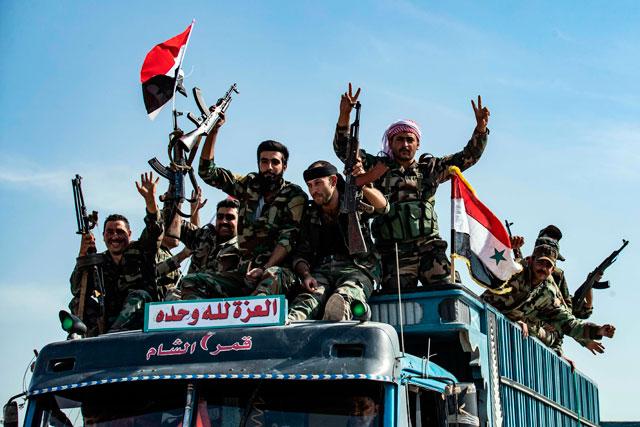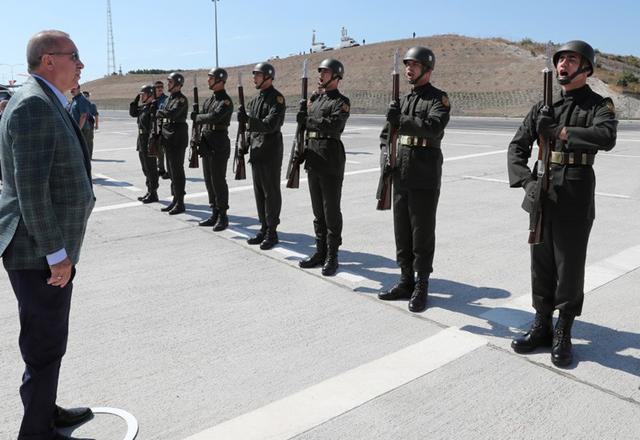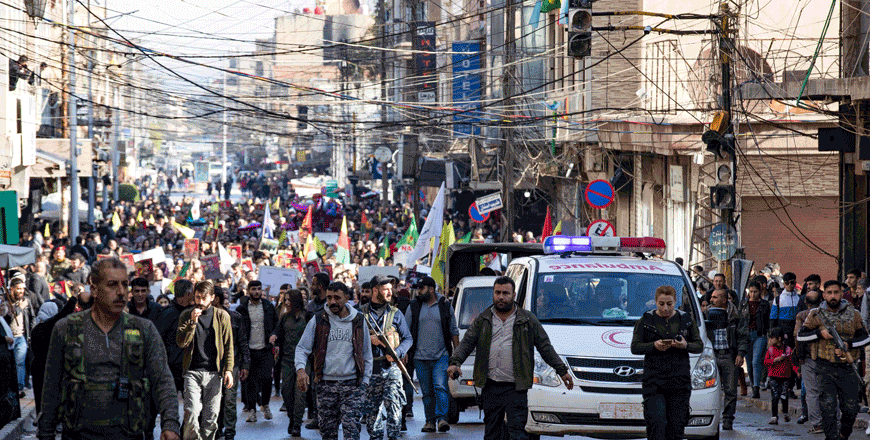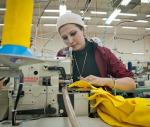You are here
Civilians flee as Syria Kurds battle Turkish invasion
By AFP - Oct 10,2019 - Last updated at Oct 10,2019

Syrian Arab and Kurdish civilians arrive to Tall Tamr town, in the Syrian northwestern Hasakeh province, after fleeing Turkish bombardment on the northeastern towns along the Turkish border on Thursday (AFP photo)
TALL TAMR, Syria — Syria's Kurds battled to hold off a Turkish invasion on Thursday as thousands of civilians fled air strikes and shelling that deepened fears of a humanitarian crisis.
US President Donald Trump tried to justify the de facto green light he gifted his Turkish counterpart Recep Tayyip Erdogan for an assault seen as a blatant betrayal of Washington's erstwhile Kurdish allies.
Syrian Kurdish forces lost 11,000 personnel and played a key role in the years-long battle to eliminate the "caliphate" the Daesh terror group had set up in the region.
In scenes all too familiar since the start of Syria's war more than eight years ago, civilians were seen abandoning their homes on Thursday, in vehicles or on foot with their belongings on their backs.
The Britain-based Syrian Observatory for Human Rights said more than 60,000 people had been displaced in less than a day.
"We're heading to the countryside because we're scared of renewed bombing and intensified clashes," said Rizan Mohammad.
"We no longer feel safe," added the 33-year-old, who was fleeing the Kurdish-majority city of Qamishli with this family after it was hit by Turkish artillery attacks on Wednesday
The broad offensive — which Erdogan dubbed "Operation Peace Spring" — drew international outrage and warnings, including from within Trump's own camp, and will be discussed in an emergency meeting of the UN Security Council later on Thursday.
After launching the assault with air strikes and intense artillery fire, the Turkish military and its Syrian proxies crossed the border into Kurdish-controlled areas.
Renewed clashes
On Thursday, Turkish jets carried out fresh strikes, the observatory and a Kurdish military official told AFP.
Fighting broke out in several locations along the roughly 120 kilometre wide front where operations are focused, the sources said.
Turkish forces and allied rebels captured seven villages in the area, the observatory said.
Fighting mostly centred around Tal Abyad — one of the main Kurdish-controlled towns in the area where Ankara wants to set up a buffer zone stretching some 30 kilometres into Syria.
Clashes also raged around Ras Al Ain further west, the other main town in the zone that Turkish media reports say is the first goal of the offensive.
According to the observatory, which relies on a network of sources in Syria, at least 23 SDF fighters and nine civilians have been killed since the start of Turkey’s operation.
On the other side of the border, five people including a baby were reported to have been killed and dozens injured in Kurdish shelling on Turkish border towns.
AFP correspondents saw fighters crossing into Syria in dozens of vehicles.
Turkey, which has carried out two previous cross-border offensives into Syria since the start of the conflict, relies heavily on Syrian proxies for ground operations.
The Syrian fighters — most of them grouped under the banner of an outfit that calls itself the Syrian National Army — are mostly Sunni Arab former rebels who were defeated by the Damascus regime.
Refugee warning to EU
Erdogan, who is politically embattled at home, wants a buffer zone in which to send back some of the 3.6 million Syrian refugees his country hosts.
He warned the European Union on Thursday that the alternative if it criticised Turkey’s military offensive was to allow the refugees to head to its shores instead.
“If you try to frame our operation there as an invasion... we will open the doors and send 3.6 million migrants to you,” Erdogan said in a speech to the Turkish parliament.
Fourteen humanitarian organisations, including the Norwegian Refugee Council and Mercy Corps, issued a joint warning that hundreds of thousands of people were in danger.
“An estimated 450,000 people live within 5 kilometres of the Syria-Turkey border and are at risk if all sides do not exercise maximum restraint and prioritise the protection of civilians,” a joint statement said.
The SDF — which have little armour and no air force — are unlikely to hold out very long against Turkish firepower in the flat and open terrain along the border.
“The question that remains is how far can Turkey advance before international or regional actors, stop it,” said Nick Heras, an analyst at the Centre for a New American Security.
The assault had seemed almost inevitable after Trump announced on Sunday that the US troops deployed in the area were pulling back from the border.
The withdrawal was implemented the next day, effectively clearing the way for Turkey to move in.
Trump has since tried to weather the international and domestic backlash, warning he would “wipe out” Turkey’s economy if the operation was not conducted “in as humane a way as possible”.
One of the Kurds’ last hopes is that the prospect of Daesh prisoners breaking out and regrouping with increasingly active sleeper cells will spur the world into action.
The Kurds hold thousands of suspected Daesh fighters of dozens of nationalities whose countries of origin have refused to take back.
On Thursday, the Kurdish administration said a prison housing Daesh fighters in the region under its control was hit by Turkish bombardment, but did not specify the extent of the damage or if there were any jail breaks.
Related Articles
RAS AL AIN, Syria — Kurdish fighters battled to defend a key Syrian border town from Turkish-backed forces on Tuesday as Russia seized on a
ISTANBUL — Turkey will carry out a military operation in a Kurdish-controlled area east of the Euphrates in northern Syria, Turkish Presiden
QAMISHLI, Syria — Thousands of Kurds protested on Sunday in the Syrian city of Qamishli against days of deadly Turkish cross-border st



















